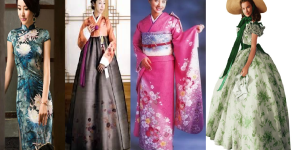
Lesson Plan ( three days)
Debates: Chinese Qipao vs. Korean Hanbok vs. Japanese Kimono vs. Western Dress
Course: Mandarin Chinese 1 ,2 or 3 Grade: 9th -12th Grade
SPECIFIC OBJECTIVE:
- In this group debate project, students will through research and debate, understand more about the oriental traditional customes from 3 different countries: Chinese Qipao, Korean Hanbok and Japanese Kimono.
- Students will use multiple visual medias such as photos, google slides to support their arguments.
- Motivate the students to learn through students guided critical thinking process, compare and contrast with Western Dress and find out the culture similarities and differences.
VALUE: Due to the icreasing of econimic and political status, there are many Americans interested in Asian cultures, fashions. However, it is not easy for the Westerners to distinguish the difference between the Asian countries. This project will help students learn the difference between the three major Asian cultures through their traditional custumes.
MATERIALS :
1. Class Chromebooks provided to each students.
2. Internet connection.
3. Speaking cones ( 4 )
4. Kahoot
DAY ONE:
The teacher will introduce the grading methods of this group project: Total project is 100 points : small group discussion notes : 30 pts ( individual) , Debate notes : 50 points ( individual) , Oral debate ( 1st team 20 pts, 2nd-18pts, 3rd-15pts, 4th=12pts) ( Group) . Individuals who present will be giving extra points add on your final score.
Then the teacher will divide the class into four groups, either random or grouping by the seating. Teacher will ask each group to select 2 group leaders to lead the discussion. Teacher will ask the group leaders to pick one traditional cloth to work on. Each group will come out with a google slide introduction their group cloth: including the orgin, the fabric, the design, the occasion for wearing them and some fun facts and so on.
DAY TWO: GROUP PRESENTATION & PREPARATION FOR DEBATE
- Each group will take turn to introduce their traditional clothes: Chinese Qipao, Korean Hanbok, Japanese Kimono and Western Dress. During the group presentation, students are required to present with the google slides they made in Day One supported with multiple visual photos and pictures.
- After the group presentation, the students will vote through Kahoot the best presented group. (Total 20 pts: 1st team will get extra 5 pts, 2nd 1extra 3 pts, 3rd extra 1 pts, 4th team no extra pts)
- After the presentation, students will discuss among their small groups, discuss the debate strategies and each students need to make notes in the group discusstion note shee ( 30 pts) ( attached) by answering the following four questions:
1. What are your 2 strongest points ( A & B) to persuade the other side? (You can do Internet research to include facts, statistics, and examples.)
2. What will the other side say to argue against point A?
3. What will the other side say to argue against point B?
4. What will you say to prove the other side’s arguments are wrong?
DAY THREE: ONCLASS DEBATES & Individual take a stand
The students will start the Oral debate during the class, teacher will be the facilitator. Each speaking individual students will earn extra 2 pts added to their final grade, and the team will receive 2 pts as well. This to motivate the students individual participations, and also could avoid some good students losing points because of they are in a weak team. At the end of the debate, all member of the first winning team will receive 20 pts, 2nd-18pts, 3rd-15pts, 4th-12pts.
The debate will base on two topics: debate on the impression to look ( 看起来)and the impression to wear ( 穿起来)。
EVALUATION (INDEPENDENT ASSESSMENT): Debate notes ( 40 pts) and Take a Stand ( 10 pts) all students need to finish the debate notes ( attached) and turn it in for grading.




Hello Jane,
I found your debate lesson quite interesting and engaging. I am teaching debate for the first time this year and I am already overwhelmed with the amount of information, details, tournaments, lessons, etc. However, I found this lesson quite effective and likely to boost student interest and engagement. I am going to be looking at this unit for mini lessons on the urban debate league curriculum and my own lessons.